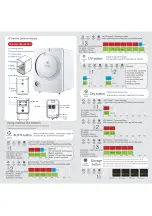
Precautions Before Use
The operator and/or the responsible authority must carefully read and completely
understand the precautions before use. If you use this instrument in an unspecified
manner, the protection it ensures can be compromised, thus putting you in danger.
• This instrument is designed for use:
-
indoors
-
in a level 2 pollution environment
-
at an altitude below 2000 m
-
at a temperature between 0° C and 40° C
-
with a relative humidity of less than 80% up to 35° C.
• The safety of all systems, including the instrument, is the responsibility of the
operator.
• It can be used for measurements on 600V CAT III circuits, relative to the ground/
earth.
• Before each use, check the condition of the insulation on the cables, boxes,
sensors and accessories. Any element on which the insulation is damaged
(even partially) must be taken out of service for repair or disposal.
• Respect the environmental and storage conditions.
• The external power supply must be connected to the instrument and to the
network (98 to 264 V
AC
).
• The power supply to the instrument is fitted with an automatically resettable
electrical protection after disappearance of the fault.
• As a safety measure, only use factory supplied parts and accessories.
• It is advised to use individual safety protection whenever the environmental
situations in which the instrument is used require it.
• When handling the sensors or test probes, do not place your fingers beyond the
physical guard.
• If the battery housing cover is absent, damaged or incorrectly positioned, the
instrument must not be used other than to adjust the sensors.
Definition of Measurement Categories (CAT)
CAT IV
Measurement category IV corresponds to measurements taken at the source
of low-voltage installations.
Example: power feeders, counters and protection devices.
CAT III
Measurement category III corresponds to measurements on building installa-
tions.
Example: distribution panel, circuit-breakers, machines or fixed industrial
devices.
CAT II
Measurement category II corresponds to measurements taken on circuits
directly connected to low-voltage installations.
Example: power supply to domestic electrical appliances and portable tools.


































